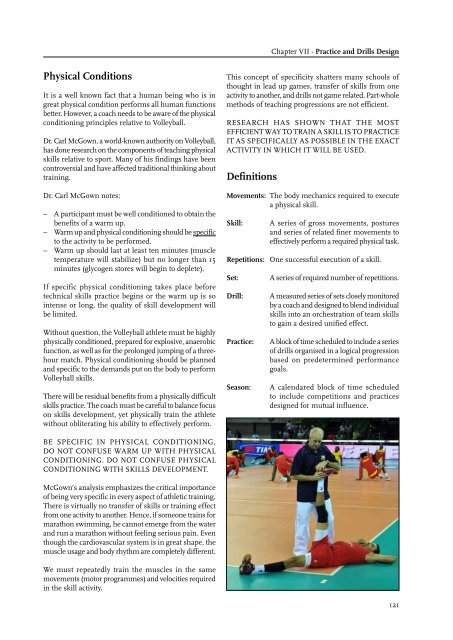COACHES MANUAL
Download
Download
- No tags were found...
You also want an ePaper? Increase the reach of your titles
YUMPU automatically turns print PDFs into web optimized ePapers that Google loves.
Chapter VII - Practice and Drills Design<br />
Physical Conditions<br />
It is a well known fact that a human being who is in<br />
great physical condition performs all human functions<br />
better. However, a coach needs to be aware of the physical<br />
conditioning principles relative to Volleyball.<br />
Dr. Carl McGown, a world-known authority on Volleyball,<br />
has done research on the components of teaching physical<br />
skills relative to sport. Many of his findings have been<br />
controversial and have affected traditional thinking about<br />
training.<br />
Dr. Carl McGown notes:<br />
––<br />
A participant must be well conditioned to obtain the<br />
benefits of a warm up.<br />
––<br />
Warm up and physical conditioning should be specific<br />
to the activity to be performed.<br />
––<br />
Warm up should last at least ten minutes (muscle<br />
temperature will stabilize) but no longer than 15<br />
minutes (glycogen stores will begin to deplete).<br />
If specific physical conditioning takes place before<br />
technical skills practice begins or the warm up is so<br />
intense or long, the quality of skill development will<br />
be limited.<br />
Without question, the Volleyball athlete must be highly<br />
physically conditioned, prepared for explosive, anaerobic<br />
function, as well as for the prolonged jumping of a threehour<br />
match. Physical conditioning should be planned<br />
and specific to the demands put on the body to perform<br />
Volleyball skills.<br />
There will be residual benefits from a physically difficult<br />
skills practice. The coach must be careful to balance focus<br />
on skills development, yet physically train the athlete<br />
without obliterating his ability to effectively perform.<br />
This concept of specificity shatters many schools of<br />
thought in lead up games, transfer of skills from one<br />
activity to another, and drills not game related. Part-whole<br />
methods of teaching progressions are not efficient.<br />
RESEARCH HAS SHOWN THAT THE MOST<br />
EFFICIENT WAY TO TRAIN A SKILL IS TO PRACTICE<br />
IT AS SPECIFICALLY AS POSSIBLE IN THE EXACT<br />
ACTIVITY IN WHICH IT WILL BE USED.<br />
Definitions<br />
Movements: The body mechanics required to execute<br />
a physical skill.<br />
Skill:<br />
A series of gross movements, postures<br />
and series of related finer movements to<br />
effectively perform a required physical task.<br />
Repetitions: One successful execution of a skill.<br />
Set:<br />
Drill:<br />
Practice:<br />
Season:<br />
A series of required number of repetitions.<br />
A measured series of sets closely monitored<br />
by a coach and designed to blend individual<br />
skills into an orchestration of team skills<br />
to gain a desired unified effect.<br />
A block of time scheduled to include a series<br />
of drills organised in a logical progression<br />
based on predetermined performance<br />
goals.<br />
A calendared block of time scheduled<br />
to include competitions and practices<br />
designed for mutual influence.<br />
BE SPECIFIC IN PHYSICAL CONDITIONING,<br />
DO NOT CONFUSE WARM UP WITH PHYSICAL<br />
CONDITIONING. DO NOT CONFUSE PHYSICAL<br />
CONDITIONING WITH SKILLS DEVELOPMENT.<br />
McGown’s analysis emphasizes the critical importance<br />
of being very specific in every aspect of athletic training.<br />
There is virtually no transfer of skills or training effect<br />
from one activity to another. Hence, if someone trains for<br />
marathon swimming, he cannot emerge from the water<br />
and run a marathon without feeling serious pain. Even<br />
though the cardiovascular system is in great shape, the<br />
muscle usage and body rhythm are completely different.<br />
We must repeatedly train the muscles in the same<br />
movements (motor programmes) and velocities required<br />
in the skill activity.<br />
121



